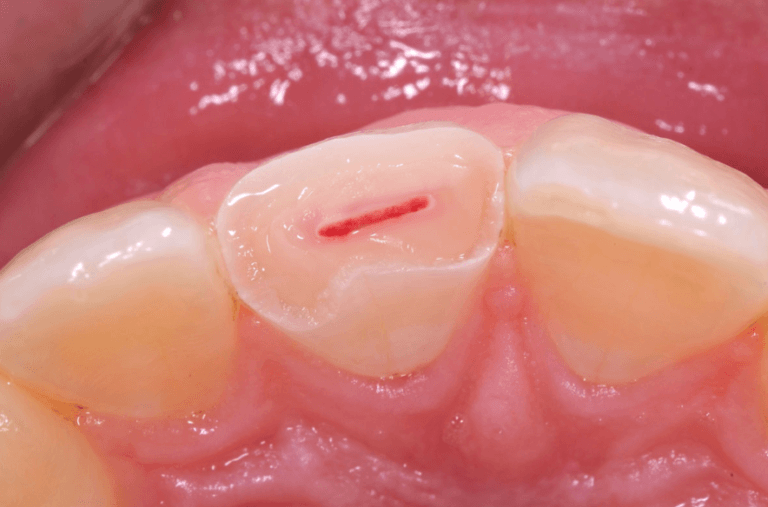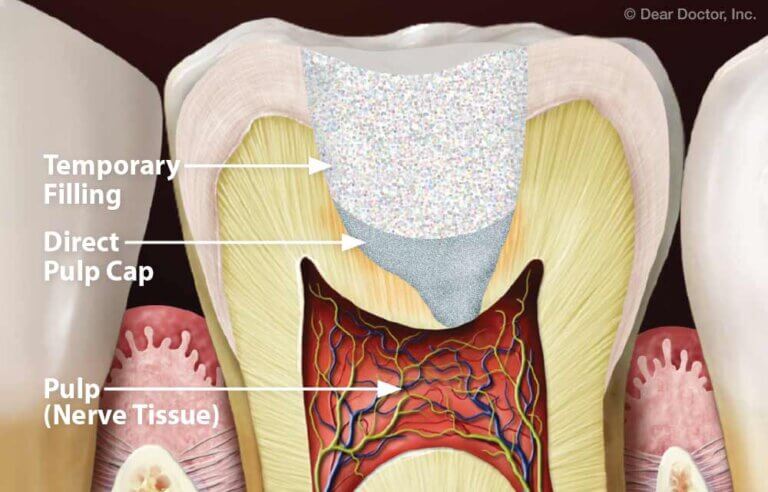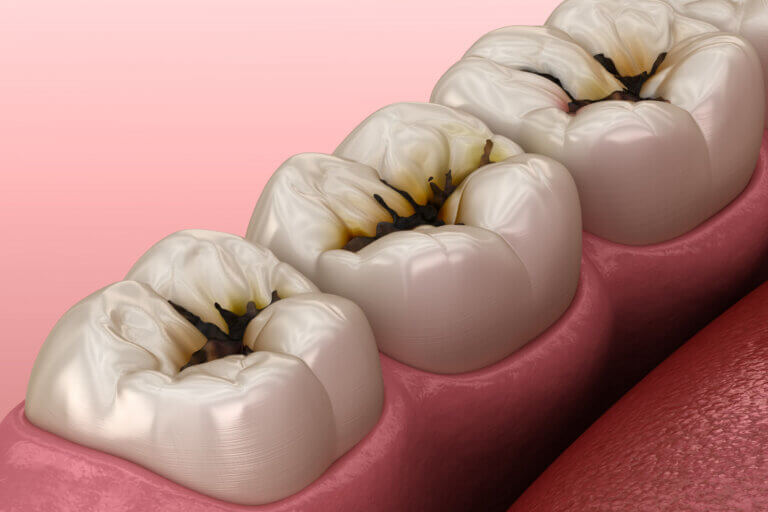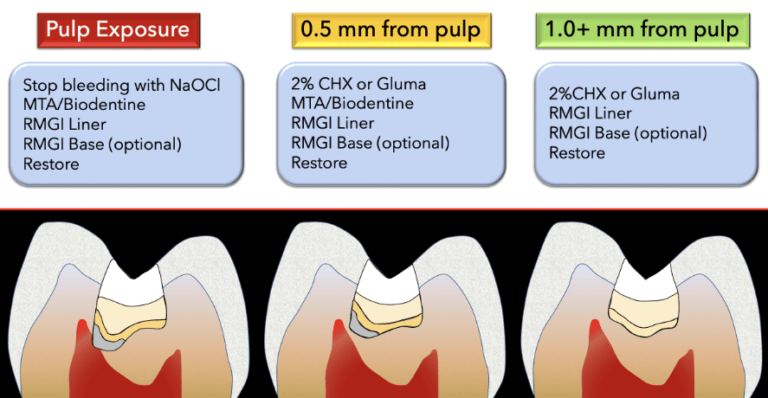Direct Pulp capping

What Is Direct Pulp Capping?
Maintaining dental health goes beyond daily hygiene; it involves understanding treatment options that can preserve your natural teeth. One such option is Direct Pulp Capping, a procedure designed to protect the innermost layer of your tooth—the dental pulp—when it has been exposed by decay, trauma, or dental work.
The dental pulp is the sensitive tissue at the core of each tooth, housing nerves, blood vessels, and connective tissue. Its role is essential for nourishing the tooth, relaying sensations (like temperature changes), and supporting tooth development. When damaged, the pulp risks infection and discomfort. Treatments like Direct Pulp Capping aim to save the pulp and avoid more extensive interventions like root canal therapy.
Before deciding on whether Direct Pulp Capping are right for you, there are some things you should know:
- Who Needs Direct Pulp Capping?
- Benefits of Direct Pulp Capping
- Indications for Direct Pulp Capping
- How Much Does Direct Pulp Capping Cost?
- Steps in the Direct Pulp Capping Procedure
- Alternative Treatments for Pulp Exposure
- Frequently Asked Questions About Direct Pulp Capping
If you have any further questions about Direct Pulp Capping or other dental services offered at Atlas Dental, please contact us.

Free phone consultation
Have questions about Dental Pulp Capping? Schedule a free phone consultation with our Toronto dentist.

5 star google reviews
Our patients love us! See for yourself why more and more people are choosing Atlas Dental for Dental Pulp Capping.

Book Emergency tooth filling
Do you think you have cavities and need a Dental Pulp Cap? Book an emergency tooth filling online.
Who Needs Direct Pulp Capping?
Direct Pulp Capping is beneficial for individuals whose pulp exposure is minor and can be protected to allow healing. Situations where this procedure may be recommended include:
- Deep Decay: When decay reaches close to the pulp, causing inflammation and discomfort.
- Dental Trauma: Physical injury that results in pulp exposure, such as a fracture or severe blow to the tooth.
- Cracked Teeth: Small cracks that allow bacteria to reach the pulp, risking infection.
- Dental Restorations: Accidental exposure during routine dental work, such as fillings or crown placements.
- Children’s Teeth: It is also sometimes used on primary teeth when preserving the tooth is important for proper dental alignment and chewing function.
Your dentist will assess your situation to determine if Direct Pulp Capping is the best approach. If you have further questions about Direct Pulp Capping, please contact us.

Benefits of Direct Pulp Capping
Choosing Direct Pulp Capping has several advantages, making it a valuable option when appropriate:
- Preservation of Natural Tooth: Helps maintain the tooth’s function and structure by protecting the pulp.
- Minimally Invasive: Compared to root canal therapy, pulp capping involves minimal removal of tooth structure.
- Strengthens the Tooth: The procedure protects and reinforces the remaining tooth structure, preserving its integrity.
- Cost-Effective: Generally less expensive than root canal treatments or tooth extractions.
- Relief from Pain and Sensitivity: Reduces discomfort caused by pulp exposure, providing a barrier that promotes healing.
While Direct Pulp Capping offers numerous advantages, it’s important to remember that its success depends on several factors, including the extent of pulp exposure, the presence of infection, and the dentist’s skill. If you have further questions about Direct Pulp Capping, please contact us.
Indications for Direct Pulp Capping
Direct Pulp Capping is generally indicated when:
- Decay is Limited: Suitable when the pulp is not extensively damaged or infected.
- Small Pulp Exposure: A tiny exposure caused by decay or minor trauma.
- No Active Infection: Direct Pulp Capping works best when no infection is present in the pulp.
- Vital Tooth: The tooth should be “alive,” meaning it reacts to stimuli like cold or heat.
- Accessible Surgical Area: The tooth must be isolated and protected effectively for the procedure.
In cases where there is extensive pulp damage, infection, or other complications, alternative treatments like root canal therapy or tooth extraction may be necessary to address the issue effectively. If you have further questions about Direct Pulp Capping, please contact us.

Cost of Dental Pulp Capping
The cost of Dental Pulp Capping, whether it is done using a direct or indirect technique, is the same as the cost of a dental filling.
Routine Dental Fillings cost $207-477 depending on the location of the tooth (anterior, bicuspid or molar), as well as the number of “surfaces” involved. Imagine each tooth as a 5 surface box. Each “surface” of this imaginary box will dictate the size (and cost) of the tooth filling. The codes relevant to regular dental fillings in the Ontario Dental Association’s Suggested Fee Guide appear as follows:
Permanent Anteriors:
- 23111 – One surface: $205
- 23112 – Two surfaces: $256
- 23113 – Three surfaces: $308
- 23114 – Four surfaces: $379
- 23115 – Five surfaces (maximum surfaces per tooth): $400
Permanent Bicuspids:
- 23311 – One surface: $226
- 23312 – Two surfaces: $283
- 23313 – Three surfaces: $339
- 23314 – Four surfaces: $414
- 23315 – Five surfaces or maximum surfaces per tooth: $435
Permanent Molars:
- 23321 – One surface: $246
- 23322 – Two surfaces: $308
- 23323 – Three surfaces: $369
- 23324 – Four surfaces: $451
- 23325 – Five surfaces or maximum surfaces per tooth: $477
Regular Dental Fillings are considered a basic service under all dental insurance plans and should be covered to your maximum insurable limit, but be sure to find out from your dental insurance plan provider how much you are eligible for before going ahead with dental treatment. Our fees are consistent with the ODA Fee Guide.
For patients without dental insurance, Atlas Dental is pleased to offer dental financing through iFinance Dentalcard. Affordable payment plans start at 7.95% for terms of 6 months to 6 years. To learn more about Dentalcard dental treatment financing, follow this link.
Steps in the Direct Pulp Capping Procedure
Here’s what to expect during a Direct Pulp Capping procedure:
- Diagnosis and Evaluation: The dentist will examine the tooth and use X-rays to determine the extent of pulp exposure.
- Local Anesthesia: The affected area will be numbed to ensure a painless procedure.
- Tooth Isolation: A rubber dam is used to keep the area dry and clean.
- Removal of Decay: Damaged tooth structure is carefully removed to access the pulp.
- Application of Medicament: A biocompatible material like calcium hydroxide is applied directly to the pulp to create a protective barrier and promote healing.
- Sealing the Tooth: The dentist restores the tooth with a filling or crown to protect the pulp and restore tooth function.
- Aftercare and Follow-Up: You’ll receive care instructions, and a follow-up visit may be scheduled to monitor the tooth’s progress.
Your dentist will carefully evaluate your specific situation and provide you with personalized guidance on whether Direct Pulp Capping is a suitable treatment option for you. If you have further questions about Direct Pulp Capping, please contact us.

Alternative Treatments for Pulp Exposure
If Direct Pulp Capping isn’t suitable, there are other options:
- Indirect Pulp Capping: Used when the pulp is close to exposure but not directly affected. The dentist places a medicated layer over the remaining dentin to protect the pulp.
- Root Canal Therapy: Recommended if the pulp is significantly infected or damaged. This involves cleaning and sealing the tooth to prevent infection.
- Tooth Extraction: In severe cases where the tooth cannot be saved, extraction may be necessary, with options for replacement like implants or bridges.
Your dentist will conduct a thorough examination and discuss these options with you, considering the long-term impact on your dental health and overall well-being. If you have further questions about Direct Pulp Capping, please contact us.
Frequently Asked Questions About Direct Pulp Capping
- What materials are used in pulp capping?
Materials such as calcium hydroxide or mineral trioxide aggregate (MTA) are commonly used due to their properties that encourage healing and protect the pulp.
- What is the success rate of dental pulp capping?
Success rates can vary but are generally higher when the procedure is performed under optimal conditions, including proper case selection and technique.
- Does pulp capping hurt?
The procedure is typically performed under local anesthesia, so you shouldn’t feel any pain. Mild discomfort may occur afterward, which can usually be managed with over-the-counter pain relievers.
- What happens if pulp capping fails?
If the pulp becomes infected or doesn’t heal, a root canal or tooth extraction may be necessary to address the issue.
Dental pulp capping is a valuable procedure for preserving the health and vitality of a tooth, potentially avoiding the need for more invasive treatments like root canals. If you have further questions about Dental Pulp Capping, please contact us.

